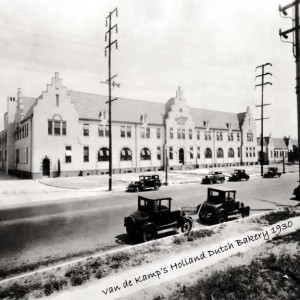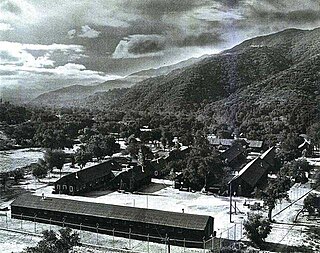
The Korean Bell of Friendship is a massive bronze bell housed in a stone pavilion in Angel's Gate Park, in the San Pedro neighborhood of Los Angeles, California. Located at the corner of Gaffey and 37th Streets, the section of the park is alternatively called the "Korean-American Peace Park" and occupies part of the former Upper Reservation of Fort MacArthur.

El Capitan Theatre is a fully restored movie palace at 6838 Hollywood Blvd. in Hollywood. The theater and adjacent Hollywood Masonic Temple is operated by Buena Vista Theatres, a subsidiary of Walt Disney Studios Motion Pictures Distribution, and as such, serves as the venue for a majority of the Walt Disney Studios' film premieres.

Cypress Park is a densely populated, 82.1% Latino neighborhood of 10,000+ residents in Northeast Los Angeles, California. It sits in the river valley created by the LA River and the Aroyo Seco, and is surrounded by hills on three sides. It is the site of the Rio de Los Angeles State Park, the LA River Bike Path and other recreational facilities. It hosts one private and four public schools.

Santa Susana Pass State Historic Park is a California State Park of approximately 680 acres (2.8 km2) located on the boundary between Ventura and Los Angeles counties, between the communities of Chatsworth and Simi Valley. Geologically, the park is located where the Simi Hills meet the Santa Susana Mountains. Here in the western part of the Transverse Ranges, the land is dominated by high, narrow ridges and deep canyons covered with an abundant variety of plant life. The park offers panoramic views of the rugged natural landscape as a striking contrast to the developed communities nearby. The park is also rich in archaeological, historical and cultural significance.

The former First Church of Christ, Scientist, built in 1912, is an historic Christian Science church edifice located at 1366 South Alvarado Street in Pico-Union, Los Angeles, California.
The Lydecker Hilltop House is an art deco house and film location in Los Angeles, California designed by Howard and Theodore Lydecker. It was designated a Los Angeles Historic-Cultural Monument by the City of Los Angeles on May 14, 2008.

The Van de Kamp Bakery Building was built in 1930 in the Glassell Park neighborhood of Los Angeles. It served as the headquarters of the chain of bakeries and coffee shops known for their distinctive windmill architecture. The building was designed by New York architect J. Edwin Hopkins to resemble a Dutch 16th century farmhouse. Originally there was a Van de Kamp's store next to the building, which was one of the first Van de Kamp's stores ever made and had the famous Van de Kamp's windmill style design. The building remains the only example of an industrial plant in the Dutch Renaissance Revival style. The bakery closed in October 1990 after Van de Kamps filed for Chapter 11. The building is a designated Los Angeles Historic-Cultural Monument, declared on May 12, 1992.

Old St. Peter's Episcopal Church is a Los Angeles Historic-Cultural Monument located in the San Pedro section of Los Angeles, California, near the Port of Los Angeles. Built in 1883 in the Carpenter Gothic Victorian architecture style, it is San Pedro's oldest church.

The James H. Dodson Residence is a Los Angeles Historic-Cultural Monument located in the San Pedro community of Los Angeles, California, near the Port of Los Angeles.

Harbor View House, formerly the Army and Navy Y.M.C.A., is a Los Angeles Historic-Cultural Monument located in the San Pedro section of Los Angeles, California, near the Port of Los Angeles. It is a five-story Spanish Colonial Revival style structure located on a bluff overlooking the harbor.

Hyde Park Congregational Church is a church in the Hyde Park section of Los Angeles. The original wooden church with two front-corner towers was declared a Los Angeles Historic-Cultural Monument in 1963. Despite the designation, the church was demolished in 1964.

The Ernest and Florence Bent Halstead House is an American Craftsman style home built in 1912 in Los Angeles, California.

The Montecito View House, located at 4115 Berenice Place in Montecito Heights, Los Angeles, is a Craftsman bungalow designed by architect Lester S. Moore and built in 1909. It was one of the very first homes constructed in Montecito Heights, and was featured on the cover of the Mutual Building Company's advertising pamphlet. Interesting aspects of the home include clinker brick and Arroyo stone chimney. The style is reminiscent of the work of Greene and Greene, Pasadena.

The Hayworth Theatre is a theater and performing arts center at 2511 Wilshire Boulevard in the Westlake neighborhood of Los Angeles, California. The facility houses 99-seat, 42-seat and 49-seat auditoriums and a 1,500 square-foot ballroom used for rehearsals, classes, and special events. The building was designated as a cultural-historic landmark by the city of Los Angeles in 1983.

Tuna Canyon Detention Station was a temporary detention facility used for holding enemy aliens who were considered by the U.S. government to be risks to national security. The detention camp was located in Tujunga at a former Civilian Conservation (CCC) Camp, constructed in 1933. The camp was converted into the Tuna Canyon Detention Station just after the bombing of Pearl Harbor. Administered by the Department of Justice, it opened on December 16, 1941, when the first group of detainees arrived from various Southern California towns and cities. Tuna Canyon had a capacity of 300, and until its closing in October 31, 1943, over 2,000 Japanese, German, and Italian immigrants, Japanese Peruvians, and others were imprisoned there. Most were transferred to other DOJ facilities like Fort Missoula, Fort Lincoln and Santa Fe. The site was used as a probation school after the war.

The S.C. Geier House is a Colonial Revival style home located in the Angelino Heights Historic Preservation Overlay Zone in Los Angeles, California. It is a 2,900-square-foot (270 m2) house built in c.1907, designed by R. L. Sholty around May of c. 1906. It was restored in 2005. It shares lot lines on either side with Los Angeles Cultural Monuments #103 Forthmann Carriage House and #808 the Neutra/Maxwell House.

Neutra/Maxwell House, referred to as the Maxwell House, is a Los Angeles Historic-Cultural Monument located in Angelino Heights, Los Angeles, California. It is a 1,200-square-foot (110 m2) Mid-Century modern house built c.1941, designed by Richard Neutra. It was relocated in 2008 from its original location at 475 North Bowling Green Way in Brentwood, Los Angeles thanks to the efforts of Barbara Behm. The Charles and Sylvie Maxwell House was designed and built by Neutra for the two musicians, she a violinist and he a composer, who wanted "acoustically suitable living quarters" on a budget of $6,750. Her practice room is farthest away from the composers study. There is a nice integration of sloping and flat roofs with the introduction of a glass triangle into the redwood siding. It was with this project that Neutra first experimented with the peaked roof and triangular glazed gable openings that later became a trademark of the firm when pitched roofs were mandated by city building codes. Further, this design element profoundly influenced the design of American suburban architecture in the 1950s and 60's.

Founded in 1983, the West Adams Heritage Association (WAHA) is an historic preservation organization in Los Angeles, California that is focused on the preservation of the Historic West Adams section of the city.





















